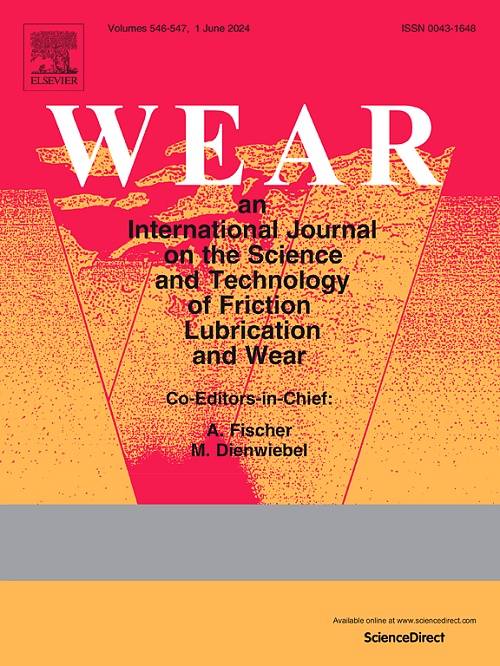Tribological analysis of kraft paper covered with exfoliated graphite films: Exploring the influence of electric current and test duration on graphene deformation, defect formation and friction
IF 6.1
1区 工程技术
Q1 ENGINEERING, MECHANICAL
引用次数: 0
Abstract
This study investigates the tribological behavior of exfoliated and reassembled graphite (ERG) films subjected to varying electrical potentials. ERG films were prepared using a novel exfoliation method, and tribological tests were conducted with a steel ball as the counterbody, under voltages of 0, 2.5, and 5 V and for different durations. Results revealed that increasing the applied voltage reduced the coefficient of friction (COF), potentially due to thermal expansion and the alignment of graphene layers induced by the electric current. For longer test durations, an increase in COF was observed, for all applied voltages, and Raman spectroscopy showed an increase in structural defects, as evidenced by the rise in the ID/IG intensity ratio. Surface topography analysis indicated significant flattening of the wear track over time, while Energy-Dispersive X-ray Spectroscopy (EDS) showed a decrease in oxygen content inside the wear track, suggesting minimal oxidation. These findings contribute to the understanding of how electric current influences the tribological properties of ERG films.
剥落石墨薄膜覆盖牛皮纸的摩擦学分析:探讨电流和测试时间对石墨烯变形、缺陷形成和摩擦的影响
本研究探讨了在不同电势下剥离和重组石墨(ERG)薄膜的摩擦学行为。采用新型的剥离方法制备了ERG薄膜,并在0、2.5和5 V电压和不同持续时间下,以钢球为counterbody进行了摩擦学试验。结果表明,施加电压的增加降低了摩擦系数(COF),这可能是由于电流引起的热膨胀和石墨烯层的排列。随着测试时间的延长,在所有施加电压下,COF都增加了,拉曼光谱显示结构缺陷增加,这可以从ID/IG强度比的增加中得到证明。表面形貌分析表明磨损痕迹随着时间的推移明显变平,而能量色散x射线光谱(EDS)显示磨损痕迹内的氧含量减少,表明氧化作用最小。这些发现有助于理解电流如何影响ERG薄膜的摩擦学性能。
本文章由计算机程序翻译,如有差异,请以英文原文为准。
求助全文
约1分钟内获得全文
求助全文
来源期刊

Wear
工程技术-材料科学:综合
CiteScore
8.80
自引率
8.00%
发文量
280
审稿时长
47 days
期刊介绍:
Wear journal is dedicated to the advancement of basic and applied knowledge concerning the nature of wear of materials. Broadly, topics of interest range from development of fundamental understanding of the mechanisms of wear to innovative solutions to practical engineering problems. Authors of experimental studies are expected to comment on the repeatability of the data, and whenever possible, conduct multiple measurements under similar testing conditions. Further, Wear embraces the highest standards of professional ethics, and the detection of matching content, either in written or graphical form, from other publications by the current authors or by others, may result in rejection.
 求助内容:
求助内容: 应助结果提醒方式:
应助结果提醒方式:


